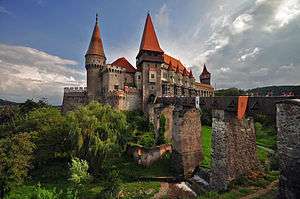Poenari Castle
Poenari Castle (Romanian pronunciation: [po.eˈnarʲ]), also known as Poenari Citadel (Cetatea Poenari in Romanian), is a ruined castle in Romania which was a home of Vlad the Impaler.[2] Access to the citadel is made by climbing the 1,480 concrete stairs.
| Poenari Citadel | |
|---|---|
Cetatea Poenari | |
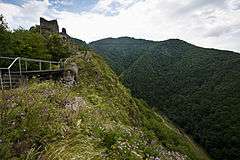 | |
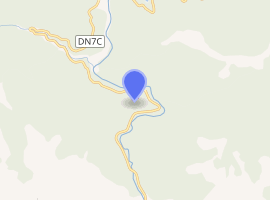
| |
| Alternative names | Citadel of Țepeș Vodă Citadel of Negru Vodă |
| General information | |
| Location | |
| Construction started | 1453[1] |
| Dimensions | |
| Diameter | 60 m |
| Design and construction | |
| Architect | Negru Vodă |
Location
The castle is located on the plateau of Mount Cetatea, facing the west side of the Transfăgărășan, on a canyon formed on the Argeș River valley, close to the Făgăraș Mountains.
History
Poenari Castle was constructed around the beginning of the 13th century by Wallachians.[3] Around the 14th century, Poenari (then known as Castle Arges) was the main citadel of the Basarab rulers.[4][5] In the next few decades, the name and the residents changed a few times but eventually the castle was abandoned and left in ruins.
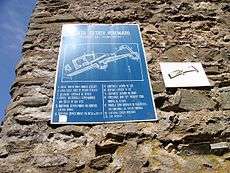
However, in the 15th century, realizing the potential for a castle perched high on a steep precipice of rock, Vlad III the Impaler repaired and consolidated the structure by enslaving his enemies from the nobility of the Danubian Principalities of Wallachia and Moldavia, making it one of his main fortresses, rebuilding the former Castle Arges on the left side of the river with stones from the older Castle Poenari, which was on the right bank and somewhat lower.[6][7] Although the castle was used for many years after Vlad's death in 1476, it eventually was abandoned again in the first half of the 16th century and was in ruins by the 17th century. The size and location of the castle made it difficult to conquer. On January 13, 1913, a landslide caused by an earthquake brought down parts of the castle which crashed into the river far below. After two further earthquakes in 1940 and 1977 that caused further damage, it was slightly repaired and the walls and its towers still stand today.[8][9] Since 2009, the site has been administered by the Argeș County Museum.[10]
In popular culture
A modern rendering of Poenari Castle was featured in the 2013 STARZ television series Da Vinci's Demons in the episode titled "The Devil" in which Leonardo da Vinci travels to Poenari Castle in Wallachia to meet with Vlad III.
The episode "The Hardy Boys & Nancy Drew Meet Dracula" of The Hardy Boys/Nancy Drew Mysteries show in the '70s takes place inside "Dracula's Castle" in "Poenari". Shots of the castle used in the episode are Poenari Castle, though the episode shows folks driving up to the castle gates for a rock festival—impossible to do, as you must climb stairs to get anywhere near the ruins.
Claims that the Poenari Castle would be the "real" Castle Dracula as featured in Bram Stoker's famous Dracula novel have no basis in Stoker's book. There is no proof that Stoker knew of Poenari Castle and the castle is situated roughly 200 km to the south of the novel's place of action, which was in the north-east corner of Transylvania.
Legends
Numerous legends and stories about Poenari Castle have survived over the centuries. During the Communist era in Romania, foreign visitors sometimes spent the night inside the ruined structure;[11] among them was Fatimeh Pahlavi's husband, Vincent Lee Hillyer, who claimed that in the night the temperature was much lower than usual in the castle (even in the month of July), smelled rotten flowers although there were none, he suffered from bizarre nightmares, inexplicably contracted Keratosis, and got the "overpowering feeling" that he was being watched and got bitten without being physically assaulted.[12][13] It was also featured as a haunted location in Ghost Hunters International in Season 1 (2008–09), episode # 14.
Gallery
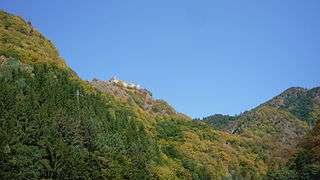
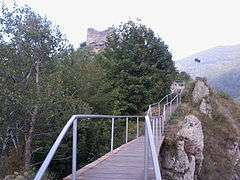
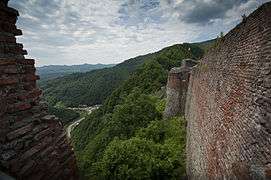
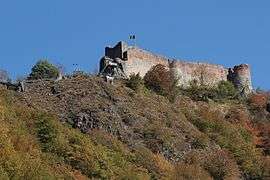
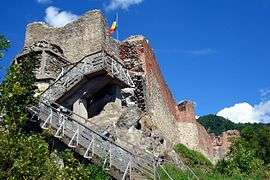
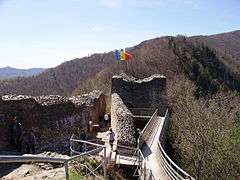
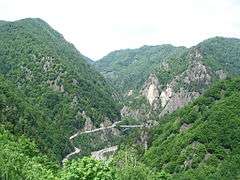 View from the citadel towards Transfăgărăşan
View from the citadel towards Transfăgărăşan
See also
References
- "Cetatea Poenari". Welcome to Romania (in Romanian).
- Cooper, Aaron (October 30, 2010). "Staking out Dracula's castle in Romania". CNN. Retrieved May 10, 2016. "STORY HIGHLIGHTS — 15th-century leader Vlad Dracula lived here, and tourists are sparse" Archived at the Wayback Machine
- In Search of Dracula, Florescu, R & McNally, T., 1994 Houghton Mifflin Company, New York, p.68
- "Poenari Fortress: The Eagles' Nest of Vlad the Impaler". Uncover Romania. Retrieved April 11, 2018.
- Guiley, Rosemary. The Encyclopedia of Vampires, Werewolves, and Other Monsters.
- Leblanc, Benjamin Hugo. Who was Vlad Dracula? — An Intriguing Figure in The Fifteenth Century. Retrieved 15 October 2019. "When he was 17 years old, Vlad Tepes (Dracula), supported by a force of Turkish cavalry and a contingent of troops lent to him by Pasha Mustafa Hassan, made his first major move toward seizing the Walachian throne. Vlad became the ruler of Walachia in July of 1456. During his six-year reign, he committed many cruelties, hence establishing his controversial reputation. His first major act of revenge was aimed at the boyars of Targoviste for not being loyal to his father. On Easter Sunday of what we believe to be 1459, he arrested all the boyar families who had participated at the princely feast. He impaled the older ones on stakes while forcing the others to march from the capital to the town of Poenari. This fifty-mile trek was quite grueling and no one was permitted to rest until they reached their destination. Dracula then ordered the boyars to build him a fortress on the ruins of an older outpost overlooking the Arges River. Many died in the process. Dracula, therefore, succeeded in creating a new nobility and obtaining a fortress for future emergencies. What is left of the building today is identified as Poenari Fortress (Cetatea Poenari)." Archived on the Wayback Machine
- In Search of Dracula, Florescu, R & McNally, T., 1994 Houghton Mifflin Company, New York, p.68
- In Search of Dracula, Florescu, R & McNally, T., 1994 Houghton Mifflin Company, New York, p.75
- Cooper, Aaron (October 30, 2010). "Staking out Dracula's castle in Romania". CNN. Retrieved May 10, 2016.
- Enciclopedia Argeșului și Muscelului - M Archived August 30, 2014, at the Wayback Machine, at the University of Pitești Enciclopedia Argeșului și Muscelului site Archived March 4, 2016, at the Wayback Machine, p. 123 (in Romanian)
- Hadden, Robert Lee. 1975. "A Night Spent in Prince Dracula's Ancient Castle." Daily Reflector (Greenville, NC newspaper). February 23, 1975, page B5.
- Guiley, Rosemary Ellen. Vampires Among Us, Visionary Living, Inc. Retrieved 15 October 2019.
- Guiley, Rosemary Ellen. The Encyclopedia of Vampires, Werewolves, and Other Monsters, Visionary Living, Inc. Pages 57-60. Retrieved 15 October 2019. "[emphasis added] In 1977 vampire researcher Vincent Hillyer received permission to spend a night alone in the castle ruins…He also wore a CROSS, which he concealed because of religious prohibitions of the then-Communist regime. In an interview for Vampires Among Us, Hillyer described his night:…that night, when I looked down, I could see the moonlight reflecting on the Argeș River below, and I thought this must be the very room that she (Vlad’s wife) had jumped from when the castle was surrounded by the Turkish troops. And she, rather than be captured alive, killed herself. And Dracula himself escaped through a secret tunnel. The cad didn’t take her with him...I fell into a heavy, uncomfortable sleep and had this strange dream that I was riding in a horse-drawn carriage that was rushing pell-mell up a winding mountain pass with precipitous cliffs. I seemed to be pursuing someone. The carriage shot around a sharp corner and came suddenly upon a Gypsy woman who was beating a fallen horse. The horse was dead, and its eyes stared blankly at the heavens. I was angered at the Gypsy’s cruelty, and I shouted at her that I would never invite her into my house. I came awake with an ominous sense of a presence, like somebody, or something, was watching me. Then I noticed this pain at my collarbone and rubbed it. I was shocked to see little drops of blood on my finger. I immediately thought, nobody is going to believe this, I spent the night in Dracula’s castle, and got puncture wounds! But I didn’t have time to think about the wounds because of this overpowering feeling that I was not alone, that somebody was watching me. And it was a feeling that was so strong that it made me turn and look down the end of the hallway…When I walked into the Posada Inn, Mrs. Velescu and the mayor of Curtea were startled at my appearance. I had a cold sweat. I went to lift my arms, and I just felt so rotten, so nauseated. I must have looked great just coming in from Dracula’s castle — pallid, about ready to faint and with a bloody neck. They took me right away to the Curtea de Argeș hospital. Mrs. Velescu didn’t believe that I had been bitten. She was startled when the doctor told her I had puncture wounds. The doctor seemed divided between whether he should be concerned or amused at my predicament, having been bitten at Dracula’s castle. He kept saying, “No, no, it wasn’t Dracula, it wasn’t Dracula, it was a spider.” It must have been a very big spider, because there was about a half an inch between the two wounds. He gave me an antitoxin shot, but I was sick with nausea, fever and malaise for about 24 hours. The bite healed in a few days. Hillyer maintained that he was then permanently sensitive to sunlight and burned easily. He developed keratoses, a pre-cancerous condition of the skin. He related his experience to experts, among them Professor Corneliu Barbulescu of the Romanic Folkloric Institute in Bucharest, Florescu, McNally, Dr. Devandra Varma -a vampirologist from India- and several psychical researchers in Southern California. From them, Hillyer pieced together theories about what had happened to him at Dracula’s Castle. The castle itself may be a sort of psychic magnet for evil because of its bloody history and the huge number of corpses buried on the mountaintop. The dream of not inviting the Gypsy woman in could relate to the superstition that the vampire cannot enter a house unless it first has been invited in. The smell of rotting flowers might have signaled the presence of malevolent forces. Smells are common in hauntings and possession cases; the worse the smell, the more negative the presence."
External links
- Photos from the castle and visitors' information
- Some pictures from the Castle
- Speculative drawings of what the castle could have looked like by illustrator Salgood Sam.
| Wikimedia Commons has media related to Poenari Citadel. |
